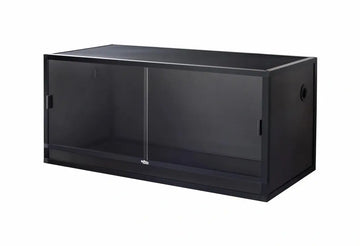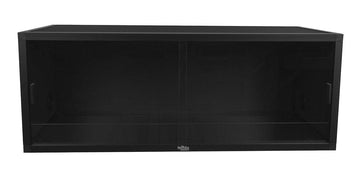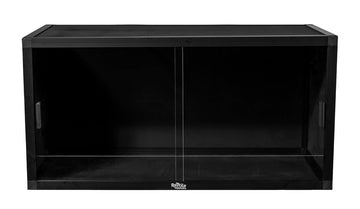Pygmy chameleons (genera Rieppeleon and Rhampholeon) are a group of 2-3.5” long, diurnal, semi-arboreal lizards native to parts of Kenya, Malawi, Tanzania, and Somalia. They prefer a montane forest habitat with cool air, plenty of moisture, and a vegetation-dense understory.
The appearance of a pygmy chameleon varies depending on the species in question. However, generally speaking, they are gray, brown, yellowish, and/or green in color and may have highlights of other colors, particularly when looking for a mate. Pattern often resembles a leaf. Some have textured skin and/or a fleshy extension on their nose. The tail varies from short to very short, and may or may not be prehensile.
Chameleons are not easy animals to keep as pets, despite their ready availability in the pet trade. Pygmy chameleons in particular are especially challenging due to their sensitivity to being kept under the wrong conditions. However, when properly housed, they can be rewarding pets that live up to 6 years.
Minimum terrarium size for pygmy chameleons
The absolute minimum enclosure size for a single pygmy chameleon is 18”L x 18”W x 18”H. Of course, larger, and particularly longer, is beneficial and will be used! Despite common claims that all chameleons “require” a full-mesh enclosure, it is actually better to use an enclosure with 2-3 solid sides, which can be done by covering the sides and back of a mesh enclosure with thin PVC panels. In dry climates, a well-ventilated glass or PVC enclosure may be more suitable. Either arrangement will help retain humidity and give the chameleon a better sense of security in its enclosure.
Housing multiple pygmy chameleons in the same enclosure is not required for their wellbeing, but it is a possibility if you have the space for a larger setup. For every additional chameleon, add at least 5 gallons to the minimum enclosure volume (25 gallons). Males should never be housed together due to the possibility of fighting and injuries.
Do pygmy chameleons need UVB?
Pygmy chameleons require UVB lighting for their long-term wellbeing. UVB lighting helps provide a clear day/night cycle, provides all of the vitamin D that your pet needs, strengthens the immune system, facilitates better digestion, and other benefits.
Here are the best UVB bulbs for pygmy chameleons housed in an 18-24” tall enclosure:
- Arcadia ShadeDweller Arboreal UVB kit
- Zoo Med T8 Reptisun 5.0
For best results, house the UVB bulbs in a high-quality reflective reptile lamp fixture. Make sure that the fixture your UVB bulb is housed in does not have a clear plastic bulb cover, as plastic and glass block UVB. Place the basking branch so the chameleon’s back will be 6” below the lamp. If needed, you can use wood blocks or similar to prop up the lamp further from the terrarium’s top for more distance.
If you plan to have live plants as part of your setup, you will also need to install a ~6500K fluorescent plant grow light.
Lights should be on for 12 hours/day. All lamps should be turned off at night.
Best temperature for pygmy chameleons
Some say that it’s best to keep pygmy chameleons at room temperature, but it’s actually best to give them a gradient of temperatures within their preferred thermal range. That being said, they don’t need much — if anything, achieving the lower end of their temperature preferences is the more challenging part!
- Basking area temperature: 77-80°F
- Ambient (shade) temperature: 68-75°F
- Nighttime temperature: 58-65°F
To track the temperatures in your chameleon’s enclosure, you will need at least two digital probe thermometers. Place one probe on the basking branch and another probe on the other side of the setup, in the shade.
Provide heat for your chameleon with a low-wattage white incandescent heat bulb placed above the basking branch in a hood fixture. Do not use ceramic heat emitters (CHEs), red bulbs, or blue bulbs, as these are not as effective.
To properly cool the enclosure at night, you may need a portable evaporative cooler like the Zoo Med Repti Cooler.
Best humidity levels for pygmy chameleons
Pygmy chameleons need lots of moisture in their environment in order to stay healthy, which starts with providing high humidity. During the day, aim for 60-80% humidity, and at night that should rise to 80-100%. Humidity should be measured via digital probe hygrometer, with the probe placed in the middle of the terrarium.
Increase humidity by misting the enclosure 2-3x/day with a pressure sprayer or automatic misting system. Avoid spraying the chameleon directly. You will also need a cool mist humidifier to run at night (although this isn’t necessary if you’re already using an evaporative cooler).
Reptile humidifiers and foggers should only be used with distilled water and require frequent disinfecting to keep your reptile from getting sick.
Best substrate for pygmy chameleons
Whereas with other chameleons you can get away with not using a substrate, that is not the case for keeping pygmy chameleons, as they are known to spend a significant portion of their lives on the ground. As an added benefit, using the right substrate helps maintain correct humidity levels in your setup.
We recommend the following substrates for pygmy chameleons:
- Zoo Med Eco Earth
- Zoo Med ReptiSoil
- Exo Terra Plantation Soil
- Zilla Jungle Mix
For best results, layer a generous amount of clean, chemical-free leaf litter on top of the substrate.
Substrate should be at least 3” deep and completely replaced every 3-4 months. Remove poop and urates daily, along with contaminated substrate.
How to decorate a pygmy chameleon terrarium
An empty enclosure makes for a bored and stressed pygmy chameleon, reducing its quality of life. Keep your pet relaxed and engaged with its environment with the strategic use of décor items that encourage it to exercise natural behaviors!
You will need plenty of vines, thin branches, and foliage to decorate your terrarium. Arrange them in such a way that the chameleon has somewhere to hide as needed, with an open area under the heat lamp for basking.
All climbing branches must be securely anchored.
What to feed to a pygmy chameleon
Pygmy chameleons are insectivores. This means that they only eat insects. Here’s a basic feeding schedule:
- Babies (0-3 months) — As much as they can eat, 2-3x/day
- Juveniles (3-6 months) — 6-10 small crickets/day
- Subadults and Adults (>6 months) — 4-6 small crickets every other day
Feeder insect options: crickets, discoids, dubias, red runner roach nymphs, small hornworms, small silkworms, flightless fruit flies, house flies
Make sure to offer a wide variety of insects, not just one or two different kinds!
Supplements
You will also need calcium and vitamin supplements to prevent your chameleon from developing a deficiency. Follow this schedule for supplementing a pygmy chameleon:
- Every feeding: Arcadia EarthPro A
- Once per month: Repashy Calcium Plus LoD
Make sure that all feeder insects are well hydrated and gutloaded prior to feeding.
How to handle your pygmy chameleon
Reptiles generally don’t appreciate petting and handling in the same way that dogs and cats do. Some tolerate it more than others, but when it comes to pygmy chameleons, it’s best to be hands-off. Pygmy chameleons are fairly calm around humans, however, so it’s possible to accustom your pet to interaction via tong-feeding!
*This care sheet contains only very basic information. Although it’s a good introduction, please further your research with high-quality sources. The more you know, the better you will be able to care for your pet!
"Rieppeleon brevicaudatus 27996531" by Louis Imbeau is licensed under CC BY 4.0.











